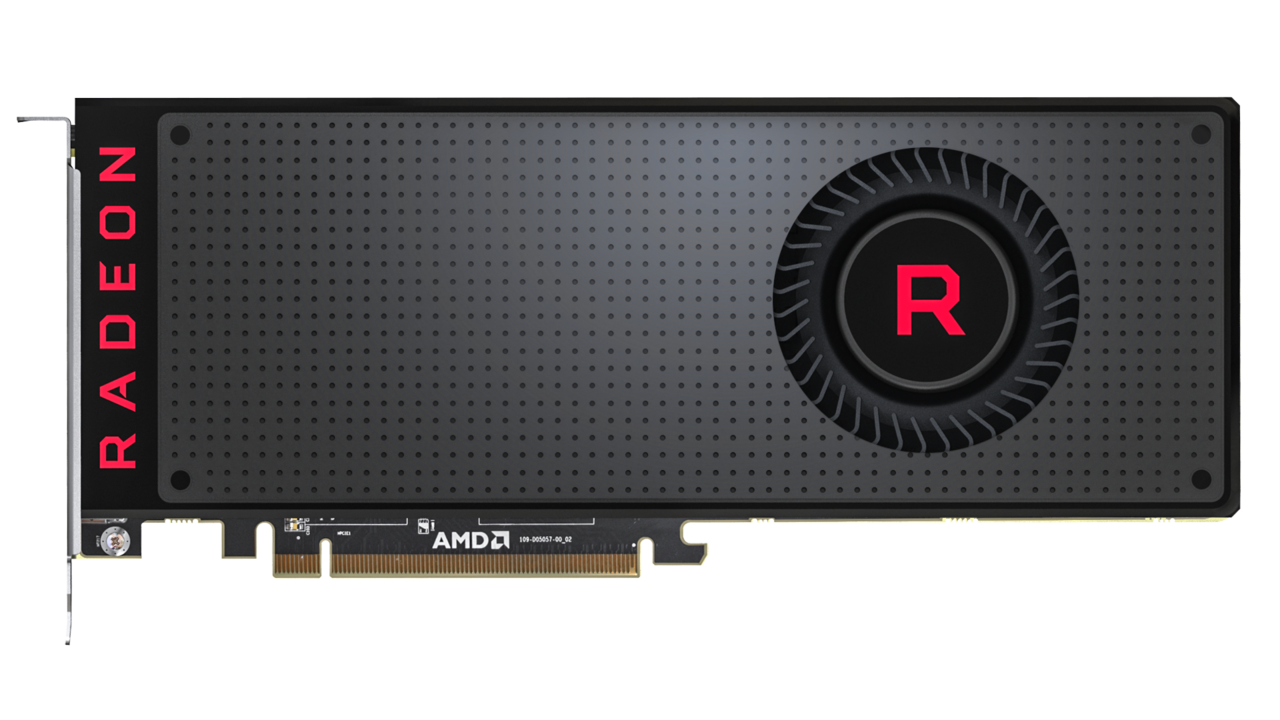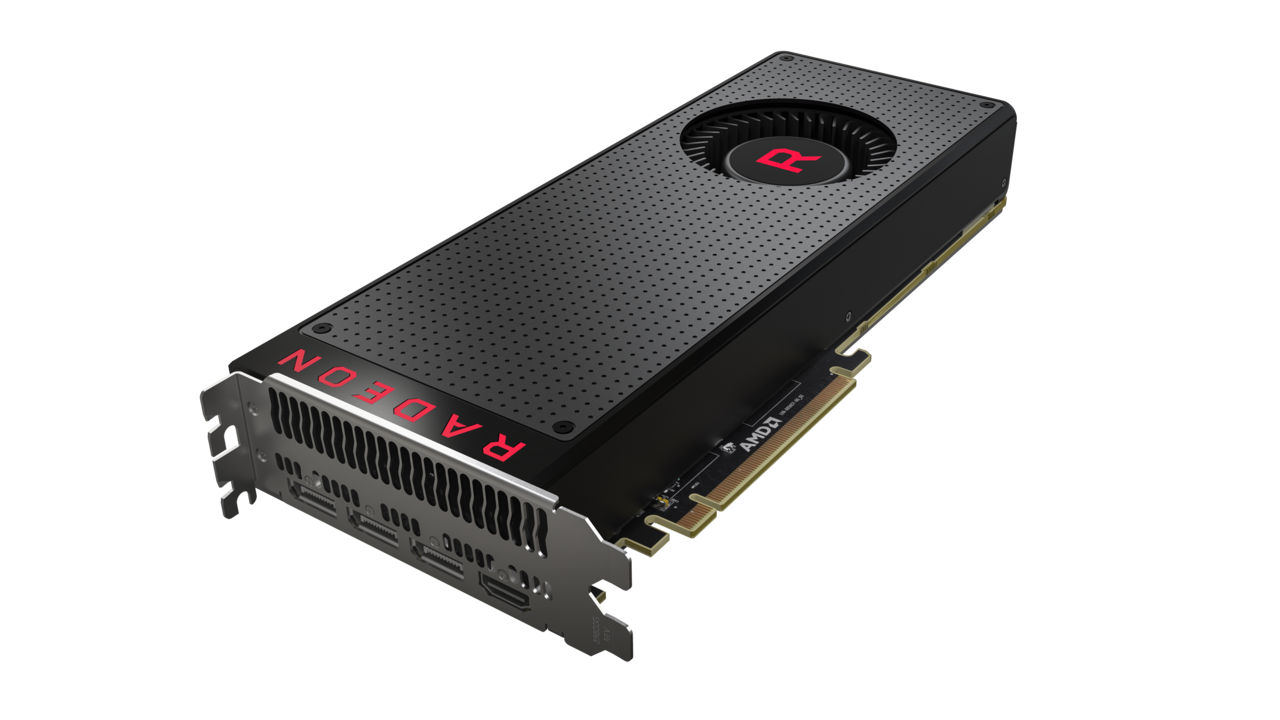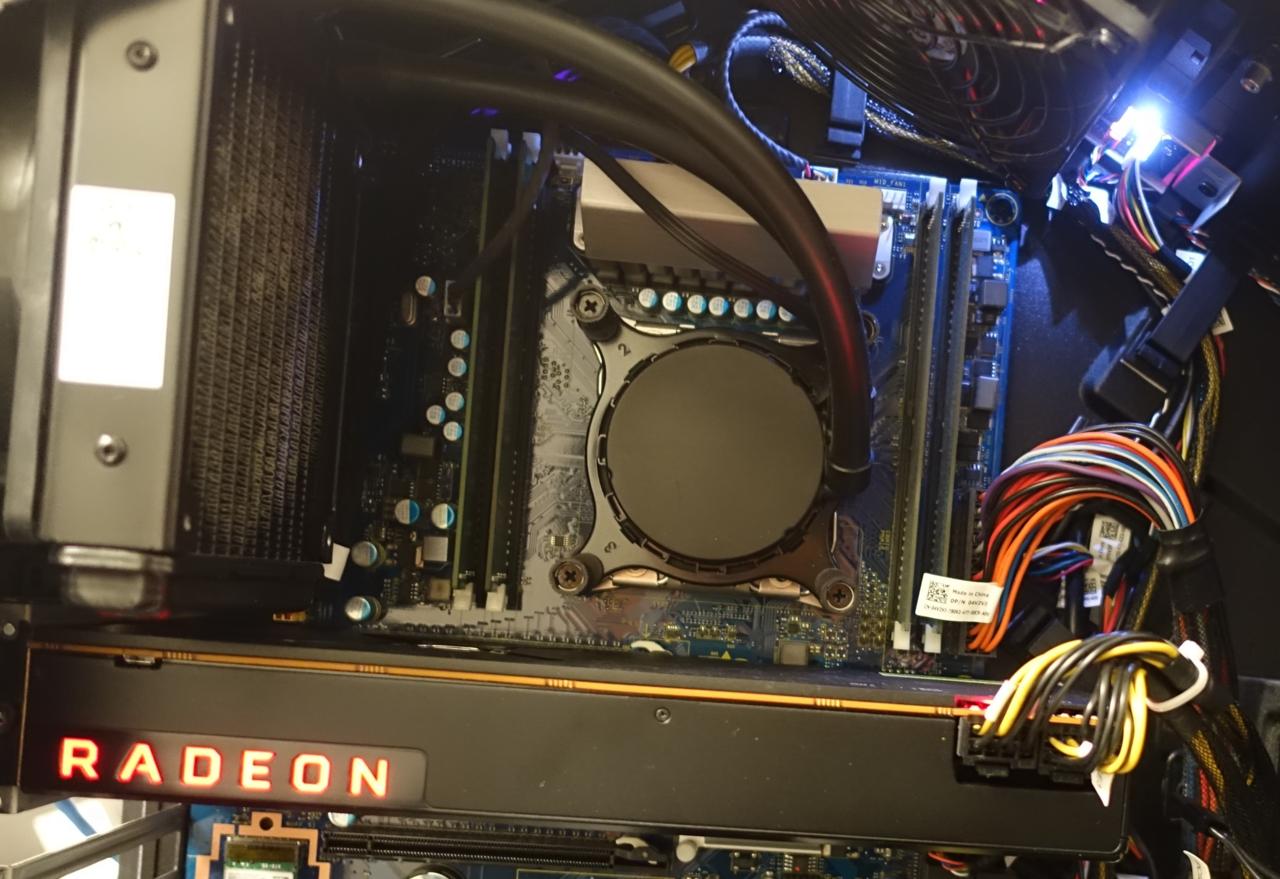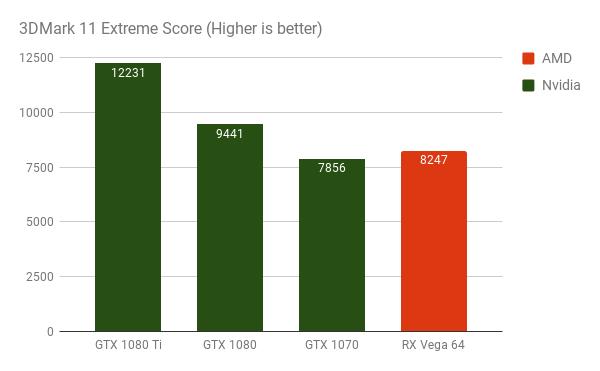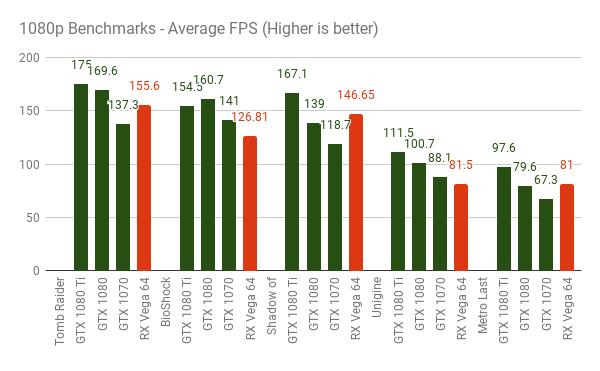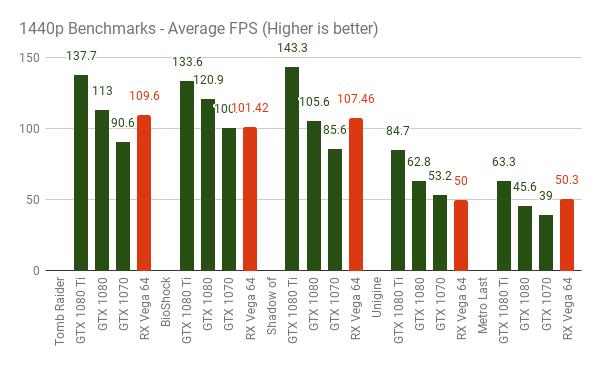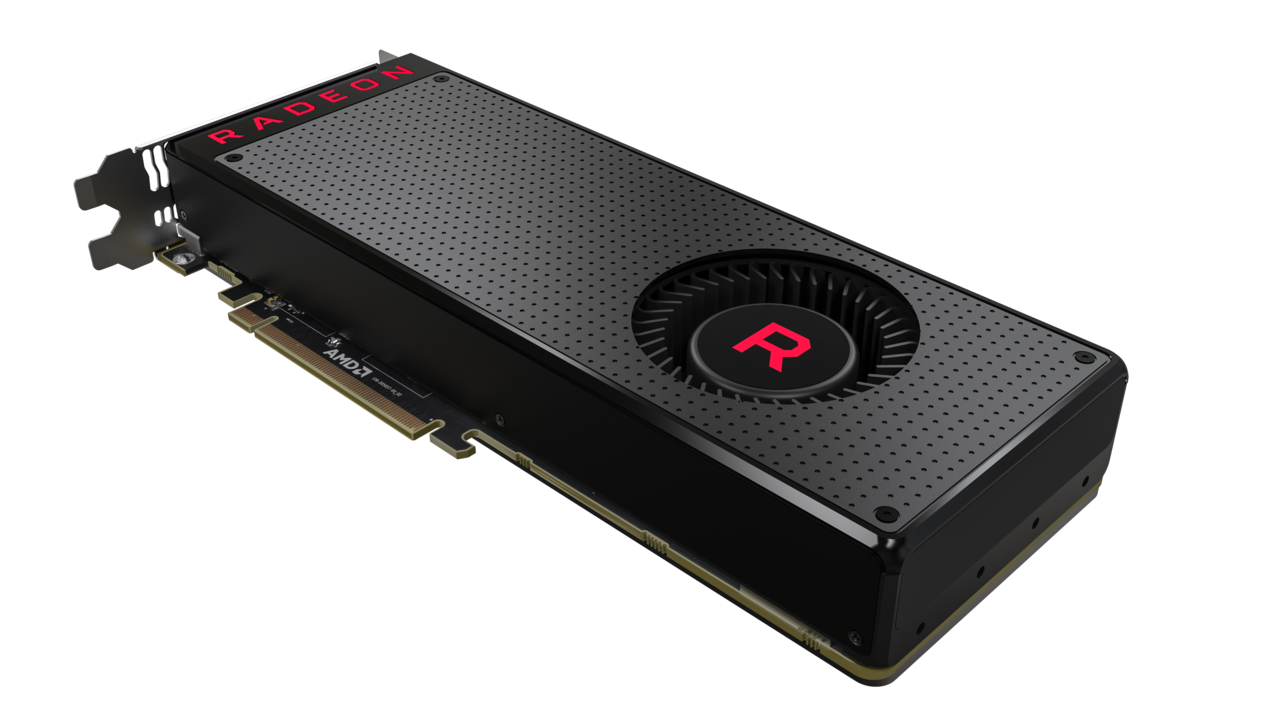AMD Radeon RX Vega 64 Review
GameSpot may receive revenue from affiliate and advertising partnerships for sharing this content and from purchases through links.
AMD Radeon RX Vega 64 Review
While AMD's 400- and 500-series Polaris graphics card were great value GPUs, they were aimed at budget-conscious gamers. This meant that Nvidia's high-end 10 series cards have remained unchallenged...until now. With AMD's new Vega GPU architecture, the company is back in the enthusiast mix and asserts that its RX Vega 64 graphics card (video review here)will be competitive with Nvidia's $550 GeForce GTX 1080 for $50 less. We're going to put that claim to the test in our review.
Table of Contents
Design
AMD offers three RX Vega 64 SKUs, which include a liquid-cooled variant and a Limited Edition version with a metallic shroud. We're reviewing the reference model, which is a dual-slot card that measures approximately 10.5 inches long and comes with a traditional black shroud coupled with one 30mm fan.
The RX Vega 64 is a power-hungry 295-watt thermal design power (TDP) card. This is unprecedented for any single GPU board we've ever reviewed. It requires a beefy 750-watt PSU with two 8-pin power connectors. That's pretty absurd when you consider that the competing GTX 1080 is a 180-watt TDP GPU. Why should you care about TDP? In addition to racking up your power bill, it means that the card may run hot, loud, and potentially hinder its overclockability.
In terms of ports, the RX Vega 64 includes three DisplayPort 1.4 connections and one HDMI output.
Specs
Spec Chart
AMD Radeon RX Vega 64 | Nvidia GeForce GTX 1080 Ti | Nvidia GeForce GTX 1080 | Nvidia GeForce GTX 1070 | |
CUDA Cores/Stream Processors | 4096 | 3584 | 2560 | 1920 |
Texture Units | 64 | 224 | 160 | 120 |
ROPs | 64 | 88 | 64 | 64 |
Core Clock | 1274MHz | 1480MHz | 1607MHz | 1506MHz |
Boost Clock | 1546MHz | 1582MHz | 1733MHz | 1683MHz |
Memory Clock | 945MHz | 11Gbps GDDR5X | 10Gbps GDDR5X | 8Gbps GDDR5 |
Memory Bus Width | 2048-bit | 352-bit | 256-bit | 256-bit |
VRAM | 8GB HBM2 | 11GB | 8GB | 8GB |
Transistor Count | 12.5B | 12B | 7.2B | 7.2B |
Teraflops | 12.7 | 11.34 | 8.9 | 6.5 |
TDP | 295W | 250W | 180W | 150W |
Manufacturing Process | 14nm FinFET | 16nm FinFET | 16nm FinFET | 16nm FinFET |
Architecture | Vega | Pascal | Pascal | Pascal |
GPU | Vega 10 | GP102 | GP104 | GP104 |
Launch Date | 8/14/2017 | 3/10/2017 | 5/27/2016 | 6/10/2016 |
MSRP | $499 | $699 | $549 | $399 |
Note: Specs like stream processors, CUDA cores, and core clocks, etc. should only be used as a frame of reference against other cards within the same family for an apples-to-apples comparison.
The RX Vega 64 partially gets its name from the fact that it has 64 compute units. Like AMD's RX 480 and RX 580 Polaris GPUs before it, Vega graphics cards are based on a 14nm FinFet production process. This contributes to its GPU efficiency. In terms of core and boost clocks, it's clocked at 1274MHz and 1546MHz, respectively. These are some of AMD's highest clock speeds to date, and the company says the card is tuned for high frequencies and should be able to boost higher than those numbers if it gets adequate power and cooling.
It uses 8GB of second-generation high-bandwidth memory (HBM2) for video RAM. HBM2 is a new type of "3D" VRAM, which means it's memory that's densely stacked vertically. It's clocked at 945MHz, but what makes it really efficient is its really wide 2048-bit memory bus. This allows the card to deliver up to 483.8GB/s of memory bandwidth. That's a lot. For reference, the GTX 1080's GDDDR5X VRAM is capped at 320GB/s. The RX Vega 64 is a 12.7 teraflop card, which trumps Nvidia’s equivalent GPU by 3.8 teraflops. As you’ll see from our benchmarks below, however, teraflop count doesn't tell the whole story.
Testing Methodology
Since AMD claims that the RX Vega 64 is competitive with Nvidia's GeForce GTX 1080, we're going to make direct comparisons against it. We're also going to add in benchmark numbers for the slightly lower-end GTX 1070 and Nvidia's flagship GeForce GTX 1080 Ti to give more context as to how these cards compare.
To ensure benchmarking consistency, we're using the same test rig for all GPUs, which is a system equipped with an Intel Core i7-5930K Haswell-E CPU clocked at 3.9GHz and 16GB of DDR4 RAM clocked at 2133MHz running in quad-channel mode.
We're going to test the cards using the same suite of synthetic, VR, and game benchmarks. These tests encompass three resolutions (1080p, 1440p, and 4K). We also ran each benchmark at their respective max settings to really put the cards through their paces.
Synthetic Benchmark
3DMark 11 Extreme is a synthetic 1080p test that provides a score and measures a GPU's DirectX 11 performance. As you can see from the chart above, the RX Vega 64 scored a 8247, which is 13 percent less than the GeForce GTX 1080. Here's a bit of a spoiler warning: The RX Vega 64 doesn't really live up to its full potential at 1080p. It appears that the resolution isn't demanding enough for it to fully flex its specs.
1080p Benchmarks
Image above from left to right: Tomb Raider, BioShock Infinite, Shadow of Mordor, Unigine Valley, Metro Last Light
The RX Vega 64 performs a bit strangely in our 1080p tests. It beats the GeForce GTX 1080 in our Shadow of Mordor and Metro Last Light benchmarks by 5.5 and 1.7 percent, respectively, but loses to the lower-tiered GeForce GTX 1070 in BioShock Infinite and Unigine Valley by a respective 10 and 7 percent. The GeForce GTX 1080 beats the RX Vega 64 by 8.2 percent in Tomb Raider, and overall, it seems like the GTX 1080 is better for standard HD gaming. A consolation prize for AMD's card here is that the RX Vega 64 never dipped below 80 average FPS in any of our tests. This indicates that it's generally overkill for 1920x1080 unless you have a really high-refresh rate monitor.
1440p Benchmarks
Image above from left to right: Tomb Raider, BioShock Infinite, Shadow of Mordor, Unigine Valley, Metro Last Light
Moving up to 2560x1440, the GeForce GTX 1080 continues to show its overall edge by repeatedly beating AMD's card in Tomb Raider, BioShock Infinite, and Unigine Valley. AMD's card does once again outperform the GeForce GTX 1080 in Shadow of Mordor and Metro Last Light by 1.7 and 10.3 percentages, respectively, however.
4K Benchmarks
Image above from left to right: Tomb Raider, BioShock Infinite, Shadow of Mordor, Metro Last Light
3840x2160 is where the RX Vega 64 really starts to pull ahead. AMD's GPU beats the GTX 1080 here in all of our 4K tests. Oddly enough, one of the biggest leads comes by way of BioShock Infinite. The GTX 1080 lost out by 22.5 percent here, which is surprising given that Nvidia's card overwhelmingly beat the RX Vega 64 in this benchmark at 1080p and 1440p.
At 4K, video RAM can really bottleneck a GPU since it has to push out so many high-resolution assets. One of the likely reasons that the RX Vega 64 comes into its own here is that it can quickly do so with its very high memory bandwidth.
While the RX Vega 64 is faster than the GTX 1080 by 24.3 percent in the graphically demanding Metro Last Light benchmark, its 24 average FPS suggests that the RX Vega 64 is certainly no GTX 1080 Ti and will still struggle to smoothly run the most taxing games at 2160p.
VR Test
The RX Vega 64 was able to get an 11 score in Valve's SteamVR Performance Test. This is considered "very high" and is the same grade that the GTX 1080 received. For more granular information, the benchmark also tells you how many frames your system was able to produce rendering Valve's virtual reality scene. AMD's card was able to generate 12,442 frames here. This is 11 percent lower than the GTX 1080 and indicates that Nvidia's equivalent GPU is better for VR.
Overclocking, Acoustics, and Temperatures
AMD has a history of struggling with thermals. Considering our air-cooled RX Vega 64 carries a crazy-high 295-watt TDP, we expected the GPU to run louder and hotter than it does. It's not quite whisper-quiet with its fan hitting around 2,400RPM when we gamed with it, but it never became a distraction and certainly never got obnoxious.
In terms of temperatures, we saw it hit a high of 81C. While this is pretty hot, it stayed in the high 70s for the most part, which is warm, but acceptable.
We tried manually overclocking the card to see how far we could push it, but unfortunately the pre-release drivers that AMD provided prevented us from doing so. We were able to perform a simple overclock by cranking the power preset from "balanced" to "turbo" using AMD's Wattman software, however. Here its core clock hit a high of 1630MHz. This is 84MHz faster than AMD's advertised boost speed.
Conclusion
Some people were hoping that AMD's leading Vega GPU would outperform the GeForce GTX 1080 Ti. Those people may be disappointed with the RX Vega 64, as Nvidia's leading $700 graphics card still remains in a league of its own, but it does largely live up to AMD's claim that it's competitive with the $550 GeForce GTX 1080. As a matter of fact, it runs slightly better at 4K given our results. It won't be able to max out every single 4K game, though. The most graphically demanding games will give it a tough time. AMD says that it's an ideal card to max out ultra-wide 3440x1440p monitors, and we'd agree and say that's where its sweet spot is.
While the RX Vega 64 is a really good card, it's a bit hard to get super excited since it's coming out more than 14 months after the GTX 1080 and doesn't completely trounce it. It also consumes a bewildering amount of power and runs a bit warm.
Still, this doesn't prevent the card from being arguably faster than the GTX 1080 for $50 less. The ball is now in Nvidia's court to respond with either a price drop or a sooner reveal of its upcoming Volta GPUs, because AMD is back with a compelling choice for enthusiast gamers.
